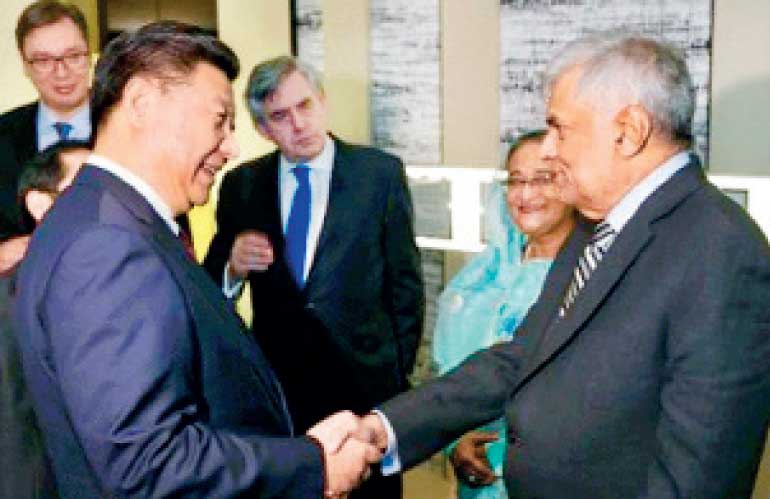2017 a decisive year; what’s in store for 2018?
 Friday, 15 December 2017
Friday, 15 December 2017‘Creating a Shared Future in a Fractured World’ is be the goal of the World Bank and the IMF in 2018.
In the last 12 months the global context has changed dramatically after Donald Trump became President of the United States. Many political issues have re-emerged on multiple fronts with wide-ranging political, economic and social consequences. Russia-USA tensions are no longer just a relic of the Cold War. Economic prosperity and social cohesion are not one and the same. The UN can no longer protect the world unity or heal itself.

Chinese President Xi Jinping greeting Prime Minister Ranil Wickremesinghe in Davos in 2017. China is key to our future economic prosperity, managing that relationship requires skill and maturity
Politically, new and divisive narratives are transforming governance. Economically, policies are being formulated to preserve the benefits of global integration while limiting shared obligations such as sustainable development, inclusive growth and managing the Fourth Industrial Revolution. Globally, citizens yearn for responsive leadership; yet, a collective purpose remains elusive despite ever-expanding social and political networks.All the while, the social contract between states, religious institutions and their citizens continues to
 erode. Therefore religious leaders are looking to rededicate leaders from all walks of life to develop a shared narrative to improve the state of the world.
erode. Therefore religious leaders are looking to rededicate leaders from all walks of life to develop a shared narrative to improve the state of the world.Given Donald Trump’s ‘belligerent’ approach to North Korea the risks posed to global economy should not be ignored. High asset prices, rapid credit growth in China, political turmoil in Catalonia and a cliff-edge Brexit are key risks to an improving global outlook.
The International Monetary Fund has also said the global economy’s recent recovery may not last, despite a pickup in activity in all western countries, except the UK. Therefore for many emerging markets, 2018 would be a very decisive year.
For Sri Lanka, given the tough oversees economic outlook and the huge debt portfolio, it’s either a saga of gloom or bloom, but from a more realistic view for Sri Lanka, it could be a balance of the two. What happens inside Sri Lanka between now and June will really determine the future direction of Sri Lanka for the next five years.
2018 outlook
Sri Lanka in 2018 needs to arrest the trend of lower foreign investment, slow growth in manufacturing, declining exports, a large trade deficit, balance of payments difficulties and low foreign exchange reserves. We will be compelled to borrow from foreign sources to repay our foreign debt obligations. According to banking sources interest rates are expected to largely remain at current levels, a corresponding drop in demand for credit in the private sector is therefore expected.In addition to the challenges on the financial sector, the slowdown in credit activity for construction is expected, and with Sri Lanka poised to become a regional and an international services hub, there would be new opportunities for public-private partnerships. A continued high-interest environment may also spark a rise in bad debt, with an increase risk in commercial real estate financing and consumer housing loans. We would certainly see new life and general buoyancy in capital markets if the regulators can get the right balance.
Sri Lanka’s annual growth pace is expected to pick up from the previous year, boosted by services, stronger manufacturing activity, agricultural growth and a pickup in domestic demand. However, like other South Asian countries, Sri Lanka too is vulnerable to political developments in the Middle East, given the reliance of South Asia on imported crude oil and employment.
Private sector
As Sri Lankan enterprises improve their governance structures, risk and compliance policies and practices, they will be better positioned to seek alternative sources of funding overseas. Easier access to capital abroad will increase competitive pressure in the domestic banking sector.Furthermore, in light of the move to create an enabling environment for business to create larger and stronger institutions that are well-capitalised, with strong regional presence, the private sector would derive scale benefits with regard to operational cost and also be able to participate in large projects to a greater degree than now.
Challenge for Sri Lanka
The big political challenge for Sri Lanka in 2018 is when Sri Lanka returns to Geneva to answer for ‘collateral damage’ which unfortunately is the futile aspect of war, the other big challenge Sri Lanka is faced with is significant revenue shortfalls.However, with all the cards in his hand the President and also the Prime Minister together should not let lesser ideals stop Sri Lanka becoming the great new entrepot of the Asia Pacific in its own right with many Western nations now standing steadfastly on our side; moreover, given the Chinese involvement in the Hambantota Port and Industrial Park and India taking over the Mattala Airport.
Then one of the biggest concerns for the world economy is that the Chinese bubble has begun to pop. The Chinese economy that grew by an extraordinary amount over the past few decades is slowing down, it is only a matter of time before China starts tightening its belt for Overseas Development Aid (ODA). Therefore, if the Chinese economy looks inward, the troubles persist in Europe, and if Trump decides to strike, it is very likely to drag the rest of the world down.
In addition, turmoil in the Middle East could adversely affected many developing countries which depend on worker remittance. So countries like Sri Lanka would need to look elsewhere for low cost capital to fund their mega infrastructure development projects and to export.
Therefore all the stakeholders must get together at the start of the year, to ensure targeted structural reforms are in place to attract foreign direct investment and expand the economy’s capacity to absorb new technology. And certainly export manufacturing can re-shape the economy in 2018.